WORLD CLASS COACHING
Winning With Inverted Fullbacks - Attacking
By Luca Bertolini
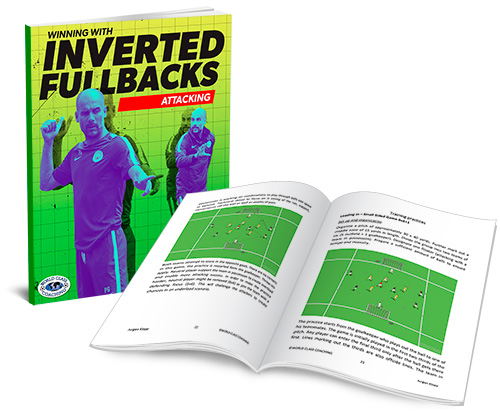
Table of Contents
PART ONE
WHY INVERTED FULLBACKS
THE ADVANTAGE OF INVERTED FULLBACKS
THE NEW CONCEPT OF INVERTED FULLBACKS
PART TWO
BUILDING UP FROM THE BACK
HOW TO COACH INVERTED FULLBACKS
DRILLS AND EXERCISES
PART THREE
POSSESSION PHASE
PART FOUR
DRILLS AND EXERCISES
A need: the first kind of inverted fullback
When a naturally left footed player was missing it was the reason to bring a right footed player to the left side as fullback; but he was asked to learn to play and to send cross passes with the left foot, because the usual runs were along and straight on the flanks, receiving the ball with the outside left foot.
These are five inverted fullback pioneers:
• Nilton Santos, a World Cup winner in 1958 and 1962
• Silvio Marzolini, five times a champion with Boca
• Giacinto Facchetti, italian right footed left-back of Internazionale Milan
• Tommy Gemmell who played for Celtic Glasgow
• Ruud Krol, maybe the greatest left fullback of the "Total Football" era at Ajax and Holland.
How to take advantage of the inverted fullback when in possession
A second kind of inverted fullback made his appearance during recent years; the appearance was not only a need, but a useful player, a support for the inverted wingers during the possession phases of play. The first players of this kind we may think about could be Philipp Lahm, Cesar Azpilicueta, and Javier Zanetti (Inter).
These three names are not recalled randomly; they are chosen to illustrate a tactical development of the past recent seasons. These players were very useful as link players for the inverted wingers.
Philipp Lahm, during Jupp Heyncke’s first seasons at Bayern Munich (2011-2013), was a link player on the left flank, between the defensive and the midfield pair of players and again, between the midfield line and the advanced players, behind the center forward.
Moreover, he was a link player and a support for Frank Ribery, the second inverted winger of Bayern Munich, together with Arien Robben on the right side.
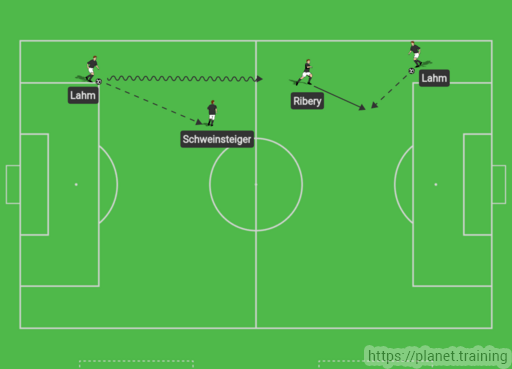
Cesar Azpilicueta (Chelsea 2013-2014) was the left fullback of Mourinho's defense.
If we go back and watch the matches of that season, we see how he was the player who dribbled the ball up the field, passing toward the inside and on the run of the right footed advanced midfielder Hazard; or who passed the ball directly on the left to keep the possession always together with Hazard.
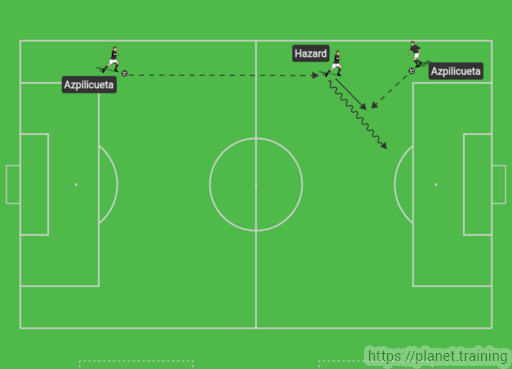
If we go back with our minds to the Mourinho's Internazionale Milan treble season (2009-2010), Javier Zanetti was used in many matches as inverted left fullback, after many season as right fullback or right center midfielder; on the right side Maicon was always in the starting line.
As the basic tactic was to stay placed under the line of the ball when the opposition was in possession, Zanetti was often asked to dribble to the ball up inside the final third and to pass the ball toward Schneider and Eto'o or Milito.
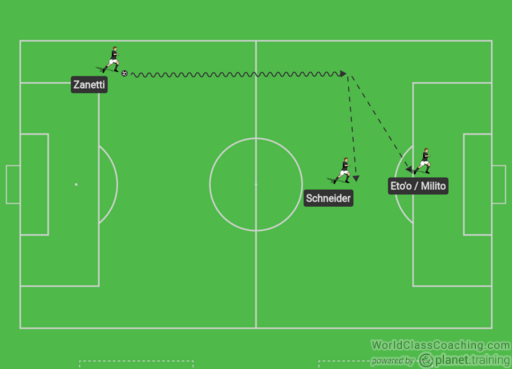
All these players were simply right footed ones on the left side, with a tactical way of play that was quite similar to a left footed player.
A new concept of "inverted fullback"
Thinking about a usually accepted division of the field, we may draw it as follows:
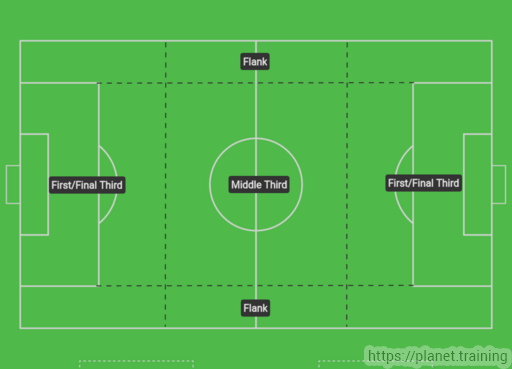
And these are the conventional directions of runs of the old style inverted fullback:
A. Dribble along the flank as deep as possible and then turn inside to pass toward a winger or a midfielder without the ball
B. Dribble just inside the final third and pass toward the center
C. Send a cross pass after a change of direction with the right foot or with left foot if possible
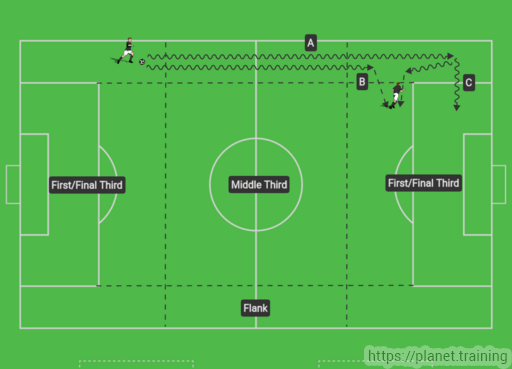
Bielsa and Guardiola started to divide the field in sections of space to be covered, rather than thinking about to the space as to be exploited when a team is in possession, or to be saved when the team is not in possession, through the division of the roles among the players.
From this concept of the space of the field, half spaces are identified on the pitch; they are not free spaces to be covered with simple defense or attacking runs, but they are spaces where the players must be active. Any player can play inside them and can cover them, from this point of view.
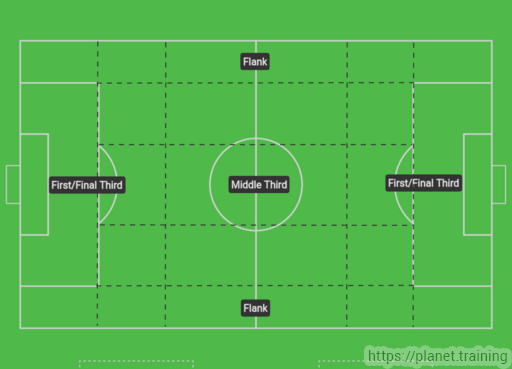
If the spaces must be occupied and if the players are not conventionally placed on the pitch with their roles anymore, all the defenders can be considered attackers when the team is in possession and the roles on the pitch depend on the situation of the moves.
And from now on, "Inverted Fullback" doesn't mean inverted foot anymore, or anyway, not only. It has to be thought as an "Inverted Run"; not along the sideline, but inside to support the midfielders.
What is very important in this way of thinking is the placement of the players inside different squares and spaces and not on the same lane. This is the reason why the fullbacks start to play inside the field.
Maybe the very first type of "Ultimate Inverted Fullback" cannot be found among the formation of Guardiola's seasons at Barcelona, where Daniel Alves and Eric Abidal/ Jordi Alba were used to play on the right foot flank where they were used to support wide the building up phase of play, dribbling toward the penalty area only to finish the move.
Guardiola's seasons as Bayern Munich and Manchester City manager are more interesting, from this point of view. Inside this book, many of his tactics will be underlined.
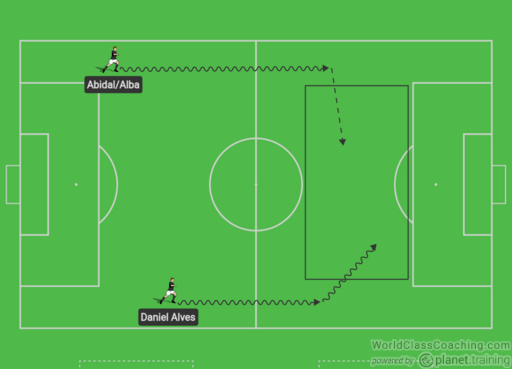
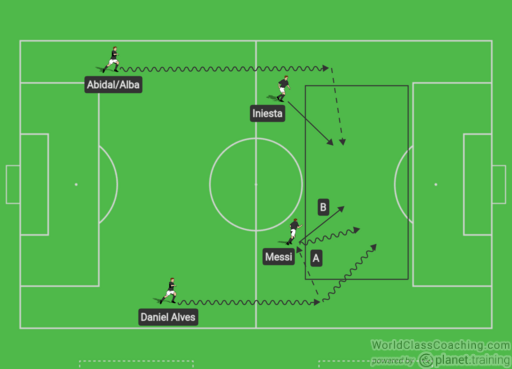
Marcelo Bielsa, who was the manager of Chilean national team at the 2010 World Cup, is very interesting, if we are to analyze inverted fullbacks.
During that World Cup tournament, he only placed one natural defender in the back line of the starting formation, Waldo Ponce. The other center back, Gary Medel, was a midfielder and he still is nowadays.
Gonzalo Jara, a right fullback or right midfielder, was the left fullback in the starting line among the back four, or a left center back among the back three.
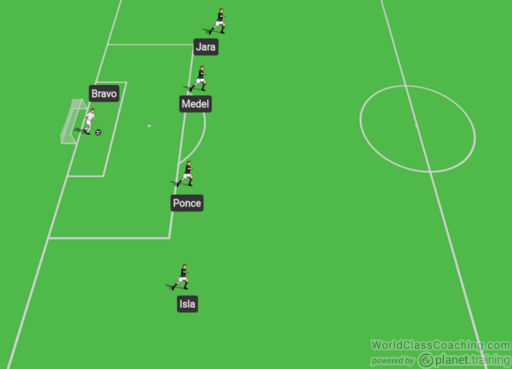
Mauricio Isla, a central midfielder or a right winger played as right fullback.
Arturo Vidal, another right footed central midfielder for the clubs he played for (Bayer Leverkusen, Juventus Fc and Bayern Munich), was placed on the pitch as left winger, to come inside during the possession phases and to leave the wide spaces free for the forwards (Sanchez, Valdivia and Suazo or Gonzalez).
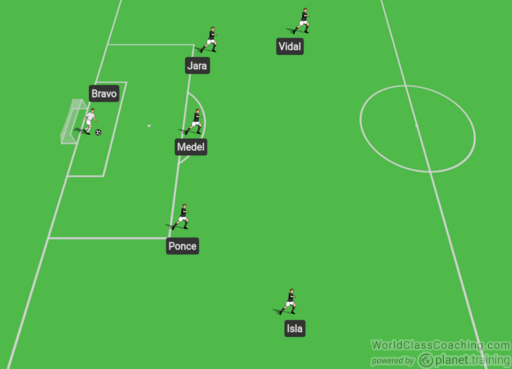
Bielsa tried to use this new concept of "inverted fullback" during the seasons at Athletic Bilbao (2011-2012 and 2012-2013), becoming the runner up of the Copa del Rey and of the Europa League.
If Barcelona’s organization during those seasons can be called "positional play,” we may call the style of play of Bielsa's Athletic Bilbao as "liquid football,” also thanks to the inside runs of the inverted fullbacks.
When the team was playing with his famous 3–3–1–3 formation, Bielsa usually lined it like it follows:
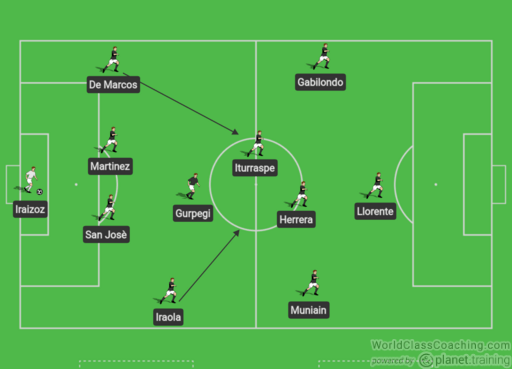
Oscar de Marcos and Iraola both played like "inverted fullbacks,” moving inside during the attacking phase and supporting the midfielders.
It is very interesting to notice that De Marcos was a right footed winger or forward.
Gabilondo and Muniain were used to start from a wide position and then to run inside without the ball too, or to receive as wide as possible and dribble inside toward the opposition's goal.
The never ending runs of all the players while in possession, made the basic formation "liquid,” and without a precise shape.
This is what Guardiola's Barcelona did, but just in the middle and final third, and not through the inverted fullbacks.
As the field is divided in spaces to be occupied, the placements of the players evolve time to time inside each single situation of the move and the patterns of play become positional play, moreover while the team is building up from the back, or playing out and near the opposition's penalty area too.
Thanks to this "philosophy or style of play,” the idea of the fullback and of his right foot on the flank has changed, and he now is a very important player as his performances and technique are crucial for the possession phases of play.
This is a potential general building up from the back situation to play out: the second pass is played toward a space to be covered.
For this reason a fullback becomes a sort of a center midfielder, creating a potential numerical advantage in the middle third.
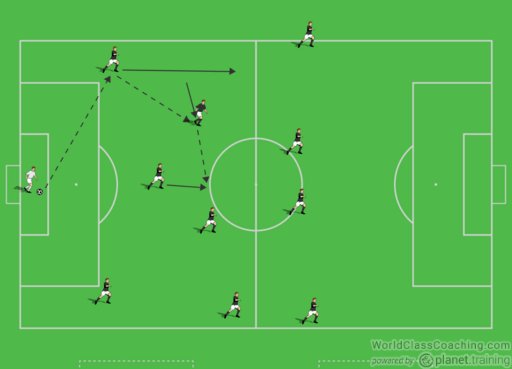
The fullbacks become midfielders, and they must be able to build up, to help and to make the possession phase safe first; and also to play decisive passes. The inverted fullback is not an inverted footed player anymore, or not only, but he's a fullback running inside rather than just an overlapping wide player.
This is the way Guardiola planned the building up and the possession phases during the three seasons as Bayern Munich manager (2013-2016). Lahm and Rafinha were the right fullbacks, Alaba and Bernat were the left ones during those seasons; but only nominally.
Lahm was the center point of the team possession tactic which was created by Guardiola to guarantee the numerical advantage in the middle third and during the building up phases of the moves; we may say the same when Rafinha and Alaba were the fullbacks as they were used to run toward the center of the field for the same reason.
This way the numerical advantage was ensured both inside the defense third, 3 v 2, and with 5 players in the middle third.
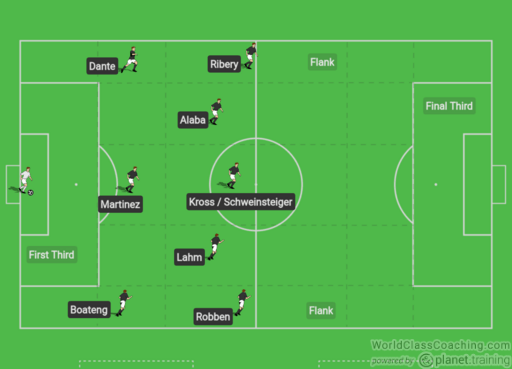
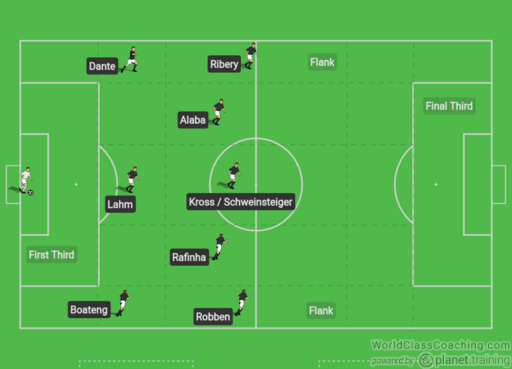
It's always hard to tell what kind of role a Bayern player had with Guardiola, as Lahm had played as right and left fullback, as center midfielder, and even like an advanced midfielder; and all the players we talked about before have played as modern inverted fullbacks.
And if we would have to sum up the players’ tactic during those seasons, we could say:
• when the team was not in possession, they had to play like a classic fullback;
• when the team was in possession phase, they had to play inside the center middle third to manage the ball leaving free outside space on the flanks in the middle and final third.
Easy to say, very hard to plan and to carry out on the field.
And it's harder if the concept of positional play must be respected:
• The spaces must be occupied;
• They must provide short and long passing solutions
• Midfielder and forwards will play along the outside lanes


